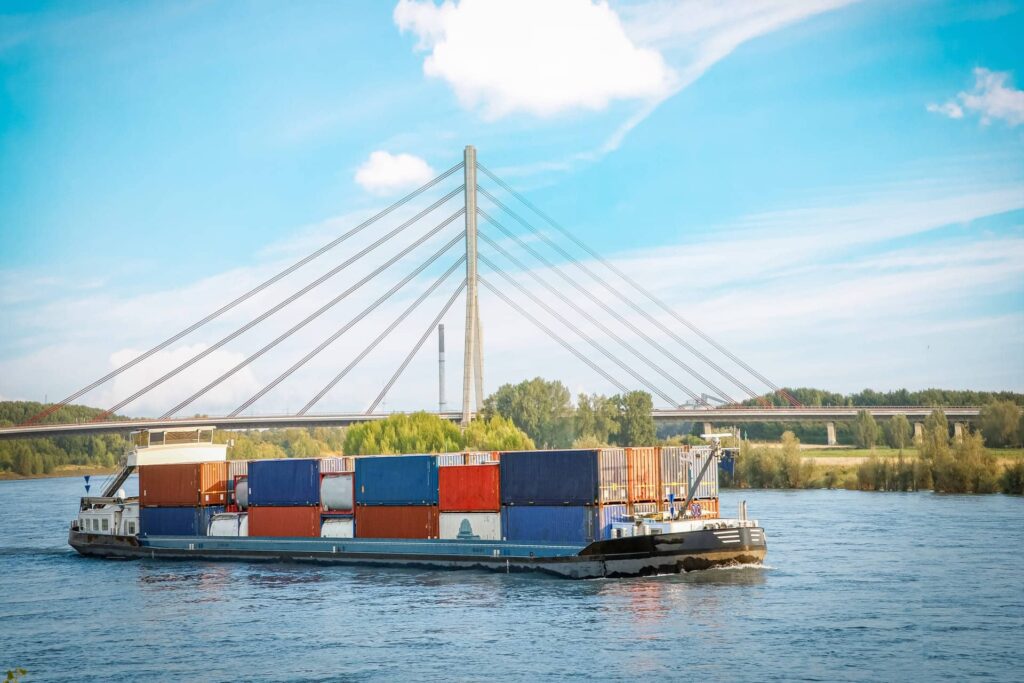The Rhine clean petroleum product (CPP) barge market remained subdued and directionless through the week of 10-14 November. Freight rates stayed flat or softened slightly on Upper Rhine routes, while Lower Rhine destinations held steady. Market sentiment was dominated by weak demand, price volatility in gasoil, and high-water levels that maintained full intakes and prevented any logistical tightening.
1. Freight Rates: Mostly Flat, Softness on Upper Rhine Routes
Freight rates showed little variation throughout the week, holding in a narrow band with small downward adjustments primarily on routes south of Koblenz:
- 10 November: Some light corrections, Duisburg fell by a small margin, while Strasbourg rose slightly (+0.50 €/ton).
- 11 November: Clear downward adjustments on Upper Rhine destinations: Karlsruhe, Strasbourg, and Basel all fell by around €0.50, reflecting lower spot demand and hesitation linked to volatile gasoil futures.
- 12 November: All routes held unchanged, with zero day-to-day movement; Basel ticked up slightly by +0.08 €/ton.
- 13 November: A modest rebound on Upper Rhine lanes, Karlsruhe (+0.25), Strasbourg (+0.50), and Basel (+0.29) driven by reduced intakes (1,700-1,800 tons) and early signs of tightening as water levels fell.
- 14 November: The week ended flat across all destinations, as all routes remain unchanged.
Takeaway: Rates remained stable to slightly weaker, with only brief upward adjustments midweek when intakes dipped.
2. Water Levels: High but Falling, Intakes Still Near Maximum
Hydrology remained largely supportive, allowing nearly full 110m barge intakes through most of the week:
- Maxau stood at 495 cm and Kaub at 215 cm, both on a gentle downward trajectory but still enabling roughly 2,000-ton intakes by November 10.
- Levels continued to ease, with Maxau at 487 cm and Kaub at 201 cm; forecasts hinted at a possible shift to 1,600–1,800-ton intakes after the weekend.
- Maxau slipped to 475 cm and Kaub to 189 cm, though still high enough to support efficient operations, with only slight further easing expected.
- Maxau dipped to 450 cm but was forecast to rebound toward 490 cm, while Kaub reached 169 cm with a predicted rise into the 152–242 cm range still sufficient for strong loadability.
Takeaway: Although water levels fluctuated, they never fell low enough to create logistical pressure or increase rates.
3. Market Activity: Low Volume, Hesitant Traders, Quiet Close
Trading activity softened as the week progressed:
- 10 November: The busiest day of the week, with 11 reported deals, mostly contract-driven and related to clearing weekend delays.
- 11 November: Only five deals concluded; traders grew reluctant due to gasoil price swings of nearly $30/ton intraday.
- 12 November: Five deals again; overall activity remained low and unchanged from the prior day.
- 13 November: Only three deals, nearly all for the Upper Rhine, as operators struggled to find spot opportunities in a calm market.
- 14 November: Just one deal, as the market fully quieted ahead of the weekend.
Takeaway: Spot demand was extremely weak, and the market closed the week in near-standstill conditions.
4. Market Drivers: Gasoil Volatility and Ample Stocks Keep Buyers on Sidelines
Several structural factors shaped market behavior during 10–14 November, keeping trading muted and sentiment cautious:
- Gasoil price volatility remained the dominant influence, with ICE gasoil contracts experiencing sharp intraday swings of $30–50/ton. This instability discouraged speculative moves and reduced willingness to commit to fresh barge bookings.
- Persistent backwardation continued to curb storage-related flows, as inland buyers opted to delay lifting product in hopes of more favorable price signals.
- Ample barge availability further softened conditions; although many vessels were occupied with COA and scheduled movements, there was no shortage of tonnage for spot inquiries, limiting any upward pressure on rates.
- Weak inland demand added to the subdued tone, with charterers well-supplied and showing little urgency to move additional volumes, particularly evident in the second half of the week.
Takeaway: A combination of volatile gasoil pricing, backwardation, and sluggish demand kept the market subdued, preventing any meaningful rate momentum.
5. Outlook: Flat Market Expected, With Slight Tightening Possible
Based on water-level forecasts and market commentary:
- Rates likely to remain flat into the following week, as no significant demand catalyst is visible.
- Possible mild tightening if water levels continue to drop toward the lower forecast ranges (esp. Kaub), but intakes remain high enough that any impact will be limited.
- Market sentiment remains cautious heading into the post-expiry period.
Takeaway: The Rhine market appears set for continued stability, with no immediate drivers for significant rate increases.
Conclusion: A Market on Hold
The Rhine CPP freight market ended 10-14 November in a quiet, directionless state. Freight rates were essentially flat, supported by high but decreasing water levels that kept barge intakes near maximum and prevented any logistical tightening. Demand remained weak throughout the week, and gasoil price volatility further discouraged fresh activity, leading to steadily declining deal numbers. With charterers well-supplied and little pressure to move product, the market closed the week subdued and stable, with only limited potential for minor tightening ahead.
What’s next?
Are you ready to face your challenges head-on?
We now offer a FREE customized trial to our BargeINSIGHTS tool, an all-in-one platform for liquid bulk barge transport optimization.
With BargeINSIGHTS, you get instant insights into barge freight rates, bunker gas oil prices, water levels, vessel tracking, and barge availability—all in one place. No more time-consuming data collection; everything you need is at your fingertips.
Click here to schedule your demo and get access to BargeINSIGHTS for free!

